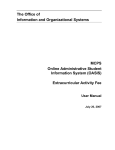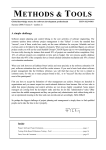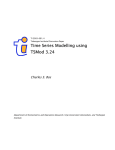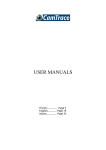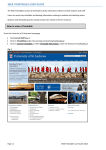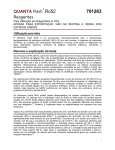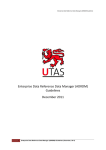Download System: web enabled agent-based university timetabling assistant
Transcript
UNIVERSITY OF NAIROBI
SCHOOL OF COMPUTING AND INFORMATICS
SYSTEM: WEB ENABLED AGENT-BASED UNIVERSITY
TIMETABLING ASSISTANT
BY: STEPHANIE GAKU
This project has been submitted as part of the fulfilment of the degree of Bachelor of
Science of the University of Nairobi.
JUNE 2012
DECLARATION
The project presented in this report is my original work and has been done with full support
of my supervisor as part of the fulfilment for Bachelor of Science in Computer Science.
Signed .........................................................
Date .............................................................
Gaku Stephanie – P15/23197/2008
This project has been submitted as part of the fulfilment for the Bachelor of Science in
Computer Science with my approval as a lecturer in the University of Nairobi, School of
Computing and Informatics and as the Project Supervisor.
Signed .........................................................
Date .............................................................
Mr. Elisha Opiyo
School of Computing and Informatics
University of Nairobi.
1
ACKNOWLEDGEMENTS
First and foremost, I would like to thank God for giving me the wisdom and strength to
develop this project to completion. I’d also want to thank my supervisor, Mr Elisha Opiyo,
for being available and resourceful at all times in the development phases of this project.
His support and ideas were major driving factor for this project.
I also thank my fellow classmates for their support and conducive environment they offered
for the period I undertook this project. I also thank School of Computing and Informatics for
convenience in opening the library and the computer laboratory which were imperative in
research done for the project.
And last but not least, I would like to show great appreciation to my family for being there at
all times and for the unconditional support they have given me throughout this period.
Thank you all.
Stephanie Gaku.
2
ABSRACT
The university course timetabling problem is a difficult problem that most universities face
on a regular basis. It is considered as an iterative and time consuming process, for it involves
a lot of negotiating and compromising of resources in order to resolve any conflicts that may
arise during the process. Currently the generation of these timetables is done manually and
the results are often not satisfactory as they do not fully optimize the institutions’
resources. Some educational institutes have tried solving this problem by the automation of
this process whereby mathematical models are used to deal with the scheduling problems.
Such an approach requires the generation of multiple mathematical models so as to satisfy
the requirements of different educational institutes. Therefore, a web based multi-agent
timetabling assistant, is proposed to solve the timetabling problem. In this case,an agent is a
computer system that is situated in some environment and is capable of independent action
so as to meet its design objectives. The proposed system will use agents to compete for a
number of resources on a given number of time slots whereby negotiation will be used as a
means for reaching compromises among agents with conflicting interests. Such a system will
significantly reduce the amount of time and energy spent ingenerating timetables and at the
same time, optimize on all the available resources as a result of using agents. Consequently,
the utilization of agents makes the system flexible whereby it is able to adapt to different
scenarios and behave in an appropriate manner and also the fact that it’s web-based makes
it easily accessible to its users.
3
Table of Contents
DECLARATION ................................................................................................................................... 1
ACKNOWLEDGEMENTS ...................................................................................................................... 2
ABSRACT ........................................................................................................................................... 3
LIST OF ABBREVIATIONS .................................................................................................................... 7
CHAPTER 1: INTRODUCTION .............................................................................................................. 8
1.1
BACKGROUND .................................................................................................................... 8
1.1.1 General Timetabling .......................................................................................................... 8
1.1.2 Timetabling in the University ............................................................................................. 9
1.2 PROBLEM DEFINITION............................................................................................................ 10
1.3 OBJECTIVES OF THE STUDY .................................................................................................... 11
1.4 SYSTEM JUSTIFICATION .......................................................................................................... 11
1.5 PROJECT SCOPE ..................................................................................................................... 12
CHAPTER 2: LITERATURE REVIEW .................................................................................................... 13
2.1 INTRODUCTION ..................................................................................................................... 13
2.2 NP-COMPLETE PROBLEMS ..................................................................................................... 13
2.3 MULTI-AGENTS SYSTEMS (MAS) ............................................................................................. 14
The scheme of the scheduling MAS.......................................................................................... 14
2.4 AN AGENT SOLUTION MODEL ................................................................................................ 15
2.4.1 Passive Mode .................................................................................................................. 16
2.4.2 Active Mode.................................................................................................................... 17
2.4.3 Parallel-active Mode ....................................................................................................... 18
2.5 THE AMAS(ADAPTIVE MULTI-AGENT SYSTEMS) THEORY ........................................................ 18
2.6 ADELFE METHODOLOGY ........................................................................................................ 19
2.7 STATISTICS ............................................................................................................................. 23
2.8RELATED WORK ...................................................................................................................... 23
Monash University Timetable System ...................................................................................... 23
Untis Express ........................................................................................................................... 24
FET .......................................................................................................................................... 24
Mimosa Scheduling Software ................................................................................................... 24
2.9 CHAPTER SUMMARY .............................................................................................................. 24
CHAPTER 3: METHODOLOGY ........................................................................................................... 25
4
3.1 PLANNING AND SELECTION .................................................................................................... 25
3.2 DATA COLLECTION ................................................................................................................. 25
3.3 METHODOLOGY ..................................................................................................................... 26
CHAPTER 4: ANALYSIS AND DESIGN ................................................................................................. 28
4.1 PRELIMINARY ANALYSIS ......................................................................................................... 28
4.1.1 Results of the interview................................................................................................... 28
4.1.2 User requirements .......................................................................................................... 29
4.1.3 The basic concept of the system architecture .................................................................. 30
4.1.4 The demands imposed by the facilities and human resources ......................................... 30
4.2 SYSTEM REQUIREMENTS ........................................................................................................ 31
4.2.1 Characterization of the environment ............................................................................... 31
4.2.2System entities ................................................................................................................ 31
4.2.3Context definition ............................................................................................................ 31
4.2.4 Determination of the use cases ....................................................................................... 36
4.2.5 Identification of co-operation failures ............................................................................. 37
4.3 DESIGN .................................................................................................................................. 38
4.3.1 Class identification .......................................................................................................... 38
4.3.2 The interclass relationships ............................................................................................. 39
4.3.3 The preliminary class diagram ......................................................................................... 40
4.3.4 Verification of the global level AMAS adequacy ............................................................... 40
4.3.5 Identification of agents ................................................................................................... 40
4.3.6 Agent Interaction with other entities............................................................................... 41
4.3.7 Verification of the local level AMAS adequacy ................................................................. 41
4.3.7 Detailed Architecture and Agent Model. ......................................................................... 42
4.3.8 Agent Architecture .......................................................................................................... 43
4.3.9 Complete design diagram ................................................................................................ 45
CHAPTER 5: IMPLEMNTATION AND RESULTS ................................................................................... 46
5.1 Hardware Platform used ........................................................................................................ 46
5.2 Software Platform used ......................................................................................................... 46
5.3 Network Platform used .......................................................................................................... 47
5.4 Choice of programming tools ................................................................................................. 47
5.4.1 PHP ................................................................................................................................. 47
5.4.2JAVASCRIPT ...................................................................................................................... 48
5.4.3 HTML .............................................................................................................................. 48
5
5.5 Coding ................................................................................................................................... 48
5.6 Testing ................................................................................................................................... 49
5.6.1 Function Testing .............................................................................................................. 50
5.6.2 Integration Testing .......................................................................................................... 52
5.6.3 System Testing ................................................................................................................ 53
5.7 Security.................................................................................................................................. 54
CHAPTER 6: DISCUSSION ................................................................................................................. 55
6.1 Achievements ........................................................................................................................ 55
6.2 Constraints ............................................................................................................................ 55
6.3 Recommendations ................................................................................................................. 55
6.4 Suggestions for Further Work ................................................................................................ 56
6.5 Conclusion ............................................................................................................................. 56
APPENDIX I ...................................................................................................................................... 57
APPENDIX II ..................................................................................................................................... 58
PROJECT PLANNING AND RESOURCES .......................................................................................... 58
PROJECT PLAN ............................................................................................................................. 58
PROJECT RESULTS AND PRODUCTS .............................................................................................. 59
RESOURCES REQUIRED ................................................................................................................ 59
BUDGET ....................................................................................................................................... 60
CONCLUSION ............................................................................................................................... 60
APPENDIX III .................................................................................................................................... 61
Data Source Sample ..................................................................................................................... 61
User Manual ................................................................................................................................ 67
REFERENCES .................................................................................................................................... 73
6
LIST OF ABBREVIATIONS
NP
Non-Deterministic Polynomial
MAS
Multi-Agent System
CHC
Common Hard Constraints
HC
Hard Constraints
SC
Soft Constraints
AMAS
Adaptive Multi-Agent Systems
NCS
Non Cooperative Situations
7
CHAPTER 1: INTRODUCTION
1.1 BACKGROUND
1.1.1 General Timetabling
According to Collins Concise Dictionary (4th Edition) a timetable is a table of events
arranged according to the time when they take place. The events are usually meetings
between people at a particular location. Consequently, a timetable specifies which people
meet at which location and at what time. A timetable must meet a number of requirements
and should satisfy the desires of all people involved simultaneously in the best possible
manner. The timing of events must be such that nobody has more than one event at the
same time.
With respect to the above considerations,the process of coming up with a timetable for any
learning institution is considered as a time consuming and interactive process that involves
a lot of compromising on both the human and technical resources offered by the university.
The technical resources would be the class rooms and the human resources would be the
lecturers and the students.Hence, university course timetabling problems are combinational
problems which consist of scheduling a set of courses within a given number of class rooms
and time periods. The diagram below illustrates the relation between concepts of
timetabling.
In order to come up with a feasible timetable, it is important to compromise between all
lecturers’ time preferences and all also keeping in mind availability of classrooms and
students, number of students and curricula.
8
1.1.2 Timetabling in the University
The university comprises of a number of schools, all located in different campuses. Each and
every school has its own timetable and over the years, the university has been generating
these timetables manually. This process is time consuming and the end result i.e. the
timetables generated, may or may not be satisfactory.
With respect to the project scope, it would be ideal to zero in to the College of Physical and
Biological Sciences that comprises of various schools that individually deal with their own
majors. For every major there is a set of associated courses, which can either be compulsory
or elective. The lecturers are shared between schools depending on the courses they teach
and there are incidents whereby students from different schools need to undertake a
common course that will require students to occupy shared room resources.
The timetable has a span of five days, starting from Monday to Friday for the undergraduate
students and each day is divided into various time slots whereby the time slot values varies
from school to school. The events that can take place in a time slot can either be a lecture or
a practical session and is given by either a lecturer or a teaching assistant. The lecturers take
place in a classrooms or lecture halls and the practical sessions take place in the labs. In
summary, an event is given by a lecturer or an assistant during a time slot in a day to a
specific group using a specific room resource. This relationship is represented by a timetable
for all events, provided that hard constraints are not violated. Hard constraints are
constraints that cannot be violated and are considered to be of great necessity to the
university operation. These constraints can be also added by some lecturers like part timers
or visiting professors. The timetable tries to satisfy other constraints which are not very
important or critical. Such constraints are known as soft constraints that should be satisfied
but maybe violated.
Lecturers can be assigned more than one courses and furthermore, some constraints can be
taken into consideration to improve the quality of education e.g. No lectures should be
scheduled in the last slot of any day or a certain day should have an activity slot for
students, and a slot where all university academics can meet. For those slots no sessions
should be scheduled
In summary the timetabling problem is too complex since a lot of constraints should be
taken into account when scheduling a session. Due to the complexity of the problem, a good
model is needed to solve the problem and this can be done through the help of a multiagents that are able to compromise conflicting interests to come up with a feasible
timetable. This would in turn save weeks of manual work.
9
1.2 PROBLEM DEFINITION
In the old days, schools taught a limited number of compulsory subjects. The number of
students as well as teachers was small and the facilities within a school environment were
limited. In contrast to old days, the modern world has advanced at a great pace in terms of
population, facilities and technology. With the advancement of the mentioned areas, the
number of students and teachers has increased, schools have expanded, more subjects are
introduced and more facilities are required to accommodate the modern education.
Therefore, there is a need to come up with a method of using every teacher, class and
facility effectively while maintaining the educational standards and this can only be done
using timetables.
Currently, the university generates its timetables manually and this process takes a period of
3-4 weeks. This process has proven to be difficult over the years since it’s generated by a
group of lecturers who need to go back and forth so as to come up with a feasible timetable.
Some of the issues that arise from generating the timetable manually is that a lot of effort is
used in creating new instances of a timetable whenever a conflict arises and this in turn
wastes a lot of time and energy. Another issue that arises is coming up with a feasible
timetable that will result in utilizing the highest productivity of teachers, optimum use of
facilities and classrooms, while maintaining the required number of timeslots for the
respectful subjects. Often the timetable generated, prove not to be satisfactory hence not
feasible.
One of the objectives is to take advantage of the latest technological advancements to come
up with a timetabling system that is able to tackle the above issues by using multi-agents
that are able to compromise conflicting interests to come up with a feasible timetable in the
shortest time possible.
10
1.3 OBJECTIVES OF THE STUDY
The main goal of the system is to
Provide the university with a web based time tabling assistant that is able to
generate a timetable from scratch given a number of constraints such as time,
number of students, classrooms capacity lecturers availability etc.
In order to effectively achieve the requirements of the time tabling assistant the following
objectives have to be met
Undertaking an understudy of the university scenario so as to come up with clear
timetable requirements.
Designing a system that proves to be flexible and scalable with increased
collaborated use of assignments.
Implementing the timetabling system and ensure that its able to
o Maximize on the schools human and technical resources
o Reduce the number of conflicts that may arise when developing the
timetable
o Ensure fair re-assignments of resources where the demand of utilities is
matched to the supply.
Testing the functionality of the system by conducting interviews so as to get people’s
views and opinions about the system.
Report and document the users’ feedback.
1.4 SYSTEM JUSTIFICATION
The web enabled agent-based university timetabling assistant will largely contribute to the
generation of feasible timetables by using negotiating agents that are able to compromise
conflicting interests in the shortest time possible. This will in turn save weeks of manual
work and effort and also improve the quality of education since the universities facilities will
be fully optimized.
11
1.5 PROJECT SCOPE
This system will focus on the collection of data from the School of Computing and
Informatics and the School of Mathematics. The information collected will then be used to
form constraints for the system so as to make the system as practical as possible.
The system will have the following modules:
The course booking module- this module will enable lecturers to book whatever
course they’d like to teach.
The time slot booking module- this module will enable the lecturers to book time
slots of their preference depending on the availability of a particular time slot.
The negotiating module- this module enables lecturers to negotiate time slots in
case they are not satisfied with the current time slot they possess.
The timetable generation module- this module is able to generate the class
timetable, the course timetable and the lecturers own schedule.
The administrator module- this module enables an administrator to add, edit, delete
and search for various components of the system. This module also supports room
allocation to various student groups.
The student module- this module enables a student to register for courses and also
view their respective timetables.
The visualization tools- this module helps visualize the availability of timeslots and
also their negotiating state.
12
CHAPTER 2: LITERATURE REVIEW
2.1 INTRODUCTION
Generating a timetable from scratch consists of scheduling a set of courses, within a given
number of rooms and time slots and due to the wide number of constraints, the generic
solutions for such problems are not always 100% compatible for the university. According to
Abdennadher and Mohamed (2007), the number of courses, academic resources, room
resources, and university specific requirements are all factors which make the problem
variant and hard. Hence the attempt made by universities to generate timetables that best
suits their needs is becomes difficult and complex as the number of constrains increase. It
goes without say that the generation of functional timetables requires a lot of time and
effort. In addition, manually generated schedules usually fail to satisfy all essential
constraints which are critical for the operation of the university. Thus, automating the
generation of course timetables is still a challenging task according to McCollum (2006).
2.2 NP-COMPLETE PROBLEMS
According to Agerbeck and Hansen (2008), Problems that can be solved by algorithms in
polynomial time are considered to be easy problems. For a problem of size n the time
needed to find a solution is a polynomial function of n.
Harder problems require an exponential function of n, which of course means that the
execution time grows much faster than for an easy problem, when the size of the problem
increases.
NP-complete problems are hard problems to solve. They belong to a class of computational
problems, for which no deterministic polynomial algorithm has been found.
NP-complete problems are a subset of the class NP (Non-Deterministic Polynomial). A Nondeterministic algorithm is able to find a correct solution, but it is not always guaranteed. The
solution is found by making a series of guesses, and the algorithm will only arrive at a
correct solution, if the right guesses are made along the way. A problem is called NP, if its
solution can be found and verified by a non-deterministic algorithm in polynomial time
In this case, the NP complete problem is scheduling the timetable and the idea of using a
multi-agent system (MAS) can be used as an intuitive approach. The system will simulate the
way humans think and interact, to construct algorithms and heuristics that can solve the NPcomplete problem i.e. timetable scheduling.
13
2.3 MULTI-AGENTS SYSTEMS (MAS)
According to Opreal(2006), Multi agent systems are concerned with coordinating behavior
among a collection of autonomous intelligent agents that work in an environment.
Sometimes, the intelligent agents are designed to reconcile their own interests with the
constraints implied by other agents or they can opt to become selfish and reconcile their
own interest with no regards to the other agents in the environment.
The complexity of multi-agent systems is generally higher than that corresponding to
conventional software systems and their success rely on properly designed and well tested
subsystems. Also, in the particular case of timetable scheduling, the MAS could find an
optimal or a sub-optimal solution using mainly inter-agent communication (with minimal
message passing).
The scheme of the scheduling MAS
14
2.4 AN AGENT SOLUTION MODEL
According to Yan, Raman and Luigi (2006), all course timetabling problems have certain
common hard constraints i.e.
1) No student has more than one course at the same time;
2) Only one course is scheduled in a classroom at any one time;
3) The classroom assigned to any course is large enough to hold all enrolled students.
By identifying the common hard constraints provides the basis to establish a general
solution model for the course timetabling problem using agent technology.
A course is an event involving course name, class time, classroom and people, i.e. students,
lecturers and teaching assistants. There are a set of constraints which govern the
relationships between these entities.
In the proposed agent solution model, each agent represents a constraint in the course
timetabling problem. The model includes the following agents:
The CHC Agent which represents the Common Hard Constraints (identified above);
The HC Agents which represent other additional Hard Constraints (such as no class
scheduled during the lunch break time);
The SC Agents which represent the Soft Constraints (such as no student assigned
more than two classes consecutively).
There is only one CHC Agent in the system. The number of HC and SC Agents depends on the
specific course timetabling problem. The constraint agents are independent of one another.
The system design is presented in three different modes of operation: the passive mode, the
active mode and the parallel-active mode.
15
2.4.1 Passive Mode
Notepad=Course timetable
= Communication between agents
The passive mode general solution model is composed of one CHC Agent, one HC Agent and
a number of SC Agents. The hard constraints can be represented by 1 HC agent or a couple
just as the Soft constraints (SC) but in order to simplify the illustration 1 HC is used.
Generally, there are more than one soft constraint in the course timetabling problem, so the
soft constraint agents are represented by the SC_1 Agent through SC n Agent where the
value of n depends on the number of soft constraints.
During the course timetabling process, the CHC Agent first produces a basic feasible course
timetable consistent with the common hard constraints. Thereafter it sends a copy of the
basic feasible timetable to each of other constraint agents. Each constraint agent evaluates
the timetable based on its own constraint and sets penalty points on the number of
constraint violations. These evaluations are sent back to the CHC Agent and it develops an
overall evaluation result on the basic feasible timetable.
Following this, the CHC Agent creates a small disturbance to the timetable and guarantees
that the disturbance does not violate the common hard constraints. The small disturbance
can be realized by either moving one course to another available position in the timetable
or exchanging the positions between two or three courses. As a timetable improvement
proposal, the disturbance is sent to the constraint agents for evaluation. The constraint
16
agents evaluate the proposal and provide feedback to the CHC Agent. After developing a
new overall evaluation result on the modified timetable, the CHC Agent decides if the
modified timetable represents an improved schedule. If the modified timetable is accepted,
the CHC Agent will adopt it as the current best timetable and inform other constraint agents
to make the same change. In this way, the system can guarantee that at any moment, the
course timetable carried by each agent is exactly the same. If the modified timetable is
rejected, the CHC Agent will discard it. The CHC Agent then continues looking for a new
proposal attempting to further improve the timetable. This process is repeated until all the
constraints violations are eliminated and a final course timetable satisfying all the
constraints is found. On the other hand, if the constraints violation cannot be reduced
further, the course timetabling process will go to the active mode described in the next
subsection.
In this timetabling mode, only CHC Agent makes proposals and all the other constraint
agents passively receive and evaluate proposals. For this reason we call this the passive
mode.
2.4.2 Active Mode
In the active each constraint agent has connections to all of others.
In addition, there is a token which is passed around between the constraint agents. Only the
agent owning the token has the right to make proposals to try to improve the course
timetable and the proposals are guaranteed not to violate its own constraint. If a proposal
violates the common hard constraints, it will be rejected because all timetables must always
be basic feasible course timetable, even if they do not reduce other constraint violations.
Otherwise, the timetabling process is similar to that of passive mode.
In the active mode, all the agents equally contribute to improve the course timetable based
on their own constraints. This allows the constraint violations to be reduced more
effectively and efficiently. That is also the reason it is called the active mode. If a solution
cannot be found after the token has been passed for a certain number of rounds among all
the agents, the timetabling process is ended hence can’t guarantee an optimal solution
satisfying all the constraints.
17
2.4.3 Parallel-active Mode
The active mode can be further modified to make the token unnecessary allowing all the
constraint agents to work in parallel.
In this situation, the CHC Agent acts as a mediator to judge if the proposals are valid or not.
Furthermore, each agent can adopt a different algorithm to create a hybrid and parallel
course timetabling solution model. In such an operation mode, the system control would be
much more complex, but it could be expected that the problem may be solved more quickly
and more effectively.
2.5 THE AMAS(ADAPTIVE MULTI-AGENT SYSTEMS) THEORY
The AMAS theory provides a solution to build complex systems for which classical
algorithmic solutions cannot be applied. The concerned systems are open and complex. All
the interactions the system may have with its environment cannot be exhaustively
enumerated; also unpredictable interactions can occur during the system functioning and
the system must adapt itself to these unpredictable events.
The solution provided by the AMAS theory is then to rid ourselves of the global searched
goal by building artificial systems for which the observed collective activity is not described
in any agent composing it .i.e. Each agent only pursues an individual objective and interacts
with agents it knows by respecting cooperative techniques which lead to avoid
unpredictable situations (like conflict, concurrency, etc.), called Non Cooperative Situations
18
(NCS). Faced with a NCS, a cooperative agent acts to reach a new cooperative state and
permanently adapts itself to unpredictable situations while learning on others. Interactions
between agents depend on their local view and on their ability to cooperate with each
other. Changing these local interactions reorganizes the system and thus changes its global
behavior.
Applying the AMAS theory consists in enumerating, according to the current problem to
solve, all the cooperative failures that can appear during the system functioning and then
defining the actions the system must apply to come back to a cooperative state.
2.6 ADELFE METHODOLOGY
The following are the activities that are involved when using the ADELFE methodology to develop a
multi-agent system
Designing agents
In the ADELFE methodology, nine stereotypes have been defined to express how an agent is formed
and/or how its behavior may be expressed:
«Co-operative agent»- A cooperative agent is an agent that possesses a cooperative social attitude.
As an object, a cooperative agent must have a run method which simulates its lifecycle which
consists in having perceptions, taking decisions and then doing actions (perceive-decide-act).
To ensure that this method does exist, an agent inherits from a super-class called Cooperative Agent.
Rule:
o
An agent-stereotyped class inherits from the Cooperative Agent class.
19
«Characteristic»- A characteristic is an intrinsic or physical property of an agent.
An attribute which is stereotyped with "characteristic" expresses the value of such a property. For
example, the size of an agent, the number of legs of an ant.
A characteristic-stereotyped method is a means to modify or update an agent property.
For example, a method that enables to modify the number of legs of an ant.
A characteristic can be called during any phase of the lifecycle of the agent. A characteristic can be
accessed or not by other agents.
«Perception» A perception is a means to receive information from the physical or social (other
agents) environment.
An attribute "perception" represents a datum coming from the environment and is necessarily
private.
For instance, the number of agents seen by an agent at a given time, a messages list.
A method stereotyped with "perception" is a means to modify or update attributes that are
stereotyped "perception". This kind of method is not necessarily private because other agents can
call it (to send a message, for example).
For example, a method that enables to put a message in an agent mailbox.
Rule:
o
An attribute stereotyped with “perception " is necessarily private.
«Action» - An action is a means to act on the environment during the action phase of an agent. An
attribute stereotyped with "action" stands for a parameter of an action.
For example, a move length, the maximum size for a message.
A method stereotyped with "action" represents a possible action for an agent.
For instance, move, send a message.
An agent is the only one which can use its actions, they are then private.
Rules:
o
an attribute which is stereotyped with "action" is private,
o
an action-stereotyped method is private,
o
a method which is stereotyped using "action" can only be called during the action
phase of an agent.
20
«Skill» -A skill-stereotyped attribute represents a datum which is useful to act on the world, or a
parameter that is linked to a skill-stereotyped method. For instance, an integer value represents a
minimal distance a robot has to respect to avoid obstacles.
A skill-stereotyped method represents a reasoning that the agent can only make during its decision
phase. For example, a method that describes the logical reasoning to avoid obstacles.
A skill-stereotyped attribute or method can only be accessed/affected or called by the agent itself to
express its autonomy of decision.
Skills can be represented by a multi-agent system when they need to evolve.
Rules:
o
an attribute or a method that is stereotyped with "skill" is necessarily private,
o
a skill-stereotyped attribute can only be used by a skill-stereotyped method,
o
a skill-stereotyped method can only be called during the decision phase of an agent.
«Aptitude»-Aptitudes show the ability of an agent to reason both about knowledge and beliefs it
owns.
An aptitude-stereotyped attribute represents a functioning datum or parameter of a reasoning
made by an aptitude-stereotyped method. For example, an integer value represents the exploration
depth of a planning tree.
A method stereotyped with "aptitude" expresses a reasoning which an agent is able to do using its
perceptions and its world representations. This method uses one or several parameters that are
attributes also stereotyped with "aptitude". For example, a method allowing actions planning or a
decision mechanism.
A method or an attribute which is stereotyped with "aptitude" can only be accessed/affected or
called by the agent itself, to express its autonomy of decision.
Rules:
o
an attribute or a method that is stereotyped with "aptitude" is necessarily private,
o
an "aptitude" attribute can only be used by a method that is also stereotyped with
"aptitude",
o
a method which is stereotyped with "aptitude" can only be called during the
decision phase of the agent,
21
o
an aptitude-stereotyped method can only call methods or attributes that are
stereotyped with perception, representation or " interaction (for instance, for
messages).
«Representation» -World representations of an agent, or beliefs, concern other agents, the physical
environment or the agent itself. These representations are used by the agent to determine its
behavior.
An attribute which is stereotyped with "representation" is a means to express a knowledge unit that
describes an agent. For example, the number of agents known by an agent is knowledge.
A method which is stereotyped with "representation" corresponds to a handling of a representation:
access, alteration... For example, a method which allows alteration of a user profile.
An attribute or a method which is stereotyped with "representation" can only be accessed/affected
by the agent itself.
Rules:
o
An attribute or a method which is stereotyped with "representation" is necessarily
private,
o
A representation-stereotyped attribute can only be used by a method which is
stereotyped with "representation" or aptitude,
o
A representation-stereotyped method can only be called during the decision phase
of the agent.
«Interaction»-The interaction language represents tools that enable an agent to communicate
directly or not with others or with its environment.
A method stereotyped with "interaction" expresses the ability an agent has to interact with other
agents or with its environment in an indirect manner.
An attribute stereotyped with "interaction" represents a functioning datum or a parameter of an
interaction made via an interaction-stereotyped method.
Rule:
o
A method stereotyped with "interaction" can only call methods stereotyped with
skill or interaction.
22
«Co-operation»-The social attitude of agents is implemented using rules allowing Non Cooperative
Situations (NCS) solving.
An agent must have a set of rules (predicates) that allow it to detect NCS. It must also have a method
to enable it to solve NCS, this method associates actions with situations in order to process them.
A method that is stereotyped with "cooperation" is always private and can be of two kinds:
o
a method that returns a boolean result to detect a situation, its parameters are
perceptions, representations or skills,
o
a solving method (a priori, one per agent) that allows the association of one or
several solving actions with each situation.
These methods are called only during the decision phase of an agent.
Rule:
o
A cooperation-stereotyped method is private.
2.7 STATISTICS
The multi-agent approach to the university course timetabling problem has proven
successful in offline experiments. We believe that its major advantages in comparison to the
other approaches of timetabling are:
It is aimed directly towards the resolution of the conflict spots in the timetable,
assuring a relatively good efficiency.
It allows different strategies and preferences to be employed within a well-defined
negotiation framework.
It is a natural computational model for some types of scheduling problems that can
be projected onto a multi-agent system in a straightforward manner.
2.8RELATED WORK
Monash University Timetable System
Monash University Timetable System is a web based timetabling system that is able to generate
timetables from scratch using different constraints such as user defined preferences. The system
then outputs the generated timetable with reference to the users’ preferences. The system has been
used for quite some while and has significantly improved the general performance of the schools’
management.Below is a link to the Monash Timetabling System.
https://mutts.monash.edu.au/mutts/timetable/bymodule.aspx?splus_year=2012
23
Untis Express
Untis Express is a timetabling assistant that enables one to enter basic data about the
school, define exactly, which teacher is available at what time, avoid the scheduling of
lessons at a particular time in is able to fact in all constraints and come up with an efficient
timetable using a self-engineered algorithm. The algorithm of Untis Express does not
calculate just one, but many different results then gives you the option to choose the one
which you like most by defining exactly which criteria are the most important ones and
which ones can be broken if necessary.
FET
FET is open source free software for automatically scheduling the timetable of a school,
high-school or university. It uses a fast and efficient timetabling algorithm. The fully
automatic generation algorithm, allows also semi-automatic or manual allocation
Usually, FET is able to solve a complicated timetable in maximum 5-20 minutes. For simpler
timetables, it may take a shorter time, under 5 minutes (in some cases, a matter of
seconds). For extremely difficult timetables, it may take a longer time, a matter of hours.
Mimosa Scheduling Software
Mimosa is a Finnish scheduling and course planning software for use in any kind of school
and university of varying type and size. Besides academic timetabling, Mimosa is used to
schedule conferences and in business and organisations. Mimosa has a very rich set of
efficient optimisation tools and interactive timetabling selections even for the most
demanding scheduling challenges. Mimosa also uses Multi-sensory approach using the
Microsoft Agent character Peedy.
2.9 CHAPTER SUMMARY
In conclusion, the generation of a feasible timetable in any educational institutions is critical for the
proper management and utilization of school resources. Therefore the automation of the
timetabling process is necessary so as to ensure the generation of feasible timetables and one way
of doing this is by using the agent based approach whereby a multi-agent system (MAS) is used.
The use of MAS would be ideal due to the fact that the course timetabling problem is considered to
be NP complete problem and the idea of using a (MAS) can be used as an intuitive approach.
The MAS uses negotiating agents also known as multi agents to reach compromises between
conflicting interests by using the active mode principles.
24
CHAPTER 3: METHODOLOGY
3.1 PLANNING AND SELECTION
The feasibility analysis carried out for the project is as discussed below.
Economic feasibility: In the initial stages, the system was economically viable to create for it
only requires the programming tools. Once the system was created, it will be taken out for
testing.
Technical feasibility: The system was deployed using a web platform which makes it easy to
access and readily available to the public to use.
Operational feasibility: it will require adequate skills in web browsing so as to experience
the efficiency and the effectiveness of the system.
Scope: The scope of the system will extend to data collection, analysis and representation of
data via the website. The system for now will focus on two schools, i.e. School of Computing
and Informatics and School of Mathematics. Maybe with time the system would be Incooperated to the university as a whole.
3.2 DATA COLLECTION
The primary means of data collection that was used so as to acquire the users’ needs was
the use of questionnaires and interviews. The interviews that were carried out were used to
acquire the techniques used to come up with a timetable manually. The logic behind coming
up with the timetable manually would then be expressed into program logic and later be
used to automate the whole timetabling system.
This information was then generalized to come up with an online system that would be able
to address majority of the users’ needs and generate a feasible timetables.
25
3.3 METHODOLOGY
The methodology that was incorporated in the system development wasthe ADELFE
methodology. ADELFE is the French acronym for "toolkit to develop software with emergent
functionality" (Atelier pour le DEveloppement de Logiciels à FonctionnalitéEmergente)
3.3.1ADELFE Overview
The ADELFE process consists of six work definitions:
Preliminary Requirements-The preliminary requirements work definition mainly deals with
the description of the system and the environment in which the system will be deployed. It
consists of defining the most appropriate system for end users.
Final Requirements- The aim of the final requirements is to transform this view in a use-case
model, and to organize and to manage the requirements (functional or not) and their
priorities.
Analysis- this involves the identification of the agents. The analysis work definition has to
develop an understanding of the system, its structure in terms of components and to know
whether or not the AMAS theory is required.
Design -The design work definition aims to formulate models that focus on non-functional
requirements and the solution domain and that prepare for the implementation and test of
the system. In ADELFE, agents being identified and their relationships being studied,
designers have now to study the way in which the agents are going to interact
After design, follows the implementation of the system where the various models of the
system are developed.
Finally, the system is tested in various capacities for any errors that could have been made
during the implementation stage. Unit testing will be done, whereby; each component of
the system is tested separately, then slowly integrated to see whether the system is able to
operate as a single unit.
26
Reasons for choosing this methodology:
This methodology was specifically designed foradaptive multi-agent systems based on the
AMAS theory. ADELFE provides a new methodology to design a society of agents exhibiting a
coherent activity.
ADELFE has been used or is used in several case studies: an intranet system design, a
timetabling problem, a flood forecast system (in progress), a mechanical design system (in
progress) and a bioinformatics system (in progress) hence it passes of as a best practice.
ADELFE is aimed to be a development toolkit of software with emerging functionalities and
not only a “mere” methodology. Therefore, ADELFE will be able to provide some tools and
libraries to ease the design and development of AMAS systems.
ADELFE uses UML and AUML notations which makes it easier to understand the system and
one is able to quickly identify all application deliverables therefore the system developers
can significantly improve project plans and track real progress.
27
CHAPTER 4: ANALYSIS AND DESIGN
4.1 PRELIMINARY ANALYSIS
The means to which preliminary requirements were gathered was through interviews. The
interviews were carried out with the people in charge of creating timetables in the school. Through
these interviews, the key requirements of the system and also techniques that would deem key to
the development of this system were attained.
The interviews were scheduled based on the interviewees’ availability. A set of questions was used
to guide the interview and are available in APPENDIX I.
4.1.1 Results of the interview
The following was noted after carrying out the interview
The current system
The university over the years has been generating timetables manually. This is done in meetings
whereby lecturers within a school sit down and distribute various courses to different lecturers.
Once that is done each lecturer is given a time slot in which they are comfortable teaching at that
time. In case of conflicts, there is need for negotiation between lecturers. Conflicts take a substantial
amount of time to resolve depending on how flexible the lecturers schedule is.
The key stakeholders for the course timetabling problem are
i.
ii.
iii.
The lecturers
Lecturers have some constraints about their availability whereby each of them have
different time preferences in which the can teach a particular lecture.
Another constraint would be the lecturers’ capability to teach a certain course whereby a
lecturer is assigned a course in which he/she is comfortable and passionate about teaching.
The students groups
A student group needs to take up a certain number of courses in a particular semester
whereby each course is allocated a number of time slots in the timetable to complete the
syllabus. (X time slots for a course 1, Y time slots for a course 2, etc.).
The lecture rooms
Lecturer rooms can either be equipped or not equipped.
The lecture rooms that are not equipped are normally used to carry out the theoretical part
of a course. The lecture rooms that are equipped have tools necessary to undertake a
practical and these rooms can only be available at a given time slot or on a certain day
because some of these facilities are shared among different student groups
The success of this system will depend on how well the system prioritizes and executes the
constraints.
4.1.2 User requirements
The system will be deployed in two schools within the university, namely, the School of Computing
and Informatics and School of Mathematics. The following will be the users of the system
The lecturers
The student groups
Course manger
Rooms manager
4.1.2.1 Functional Requirements
The following are the functional user requirements
The lecturers will need to declare their time preferences and also state their back up options
in case that particular time slot is already taken.
The students from various student groups will need to view the end result timetable.
The course manager will need to allocate different courses to the lecturers, depending on
their capability to teach that course.
The room manager will need to allocate classrooms to student groups depending on the
capacity of that particular student group and the nature of that course (practical lesson or
theoretical lesson)
The system should provide a timetable that is able to meet the users’ needs and
preferences.
4.1.2.2 Non-functional requirements
Usability - The system should provide a friendly graphical interface to ensure ease of use when the
end users utilize system functionality. The interface to the system should be inherently fail-safe, fullproof, and overly cautious in defending against accidental and intentional misuse.
Efficiency - The system should support a response time for addressing severe issues in less than 1
minute.
Availability - The system should be protected against both accidental and malicious denials of
service, and is available for use whenever it is expected to be operational.
Confidentiality - Only legitimate officials have access to the users’ confidential files and data.
Integrity - The system should be tamperproof whereby system changes are only executed by system
administrators
Security - Only legitimate officials have access to the timetable database and this would be achieved
by giving administrative passwords and usernames.
29
4.1.3 The basic concept of the system architecture
The system is web based hence making it readily available to its end-users via the internet. Each
lecturer will need access to the system using unique usernames and passwords. Thereafter they will
be assigned courses to teach using the course manager depending on their capability. The lecturers
will then be able to choose a time slot that they prefer teaching based on their availability and this
would be done through the help of the bookie.
The room manager will then need to allocate rooms to student groups based on the capacity of the
student group.
This information will then be stored in the systems database and then used to come up with a
suitable timetable that satisfies the users’ needs and preferences.
Once a suitable timetable is generated, both the lecturers and students need to view it using their
unique usernames and passwords to gain system access.
4.1.4 The demands imposed by the facilities and human resources
There are a number if constraints that need to be addressed in the development for this system.
The lecturers’ availability in terms of time
The lectures’ capability to teach a certain course
The rooms’ capacity
The rooms’ state (equipped/not equipped)
30
4.2 SYSTEM REQUIREMENTS
4.2.1 Characterization of the environment
The environment in which the system runs is said to be
Dynamic: the evolution of the active entities does not depend on the system; they are
unpredictable from the point of view of the system;
Accessible: the environment can obtain information on the state of the environment;
Non-deterministic: the system is not able to know what could be the effects of its actions on
active entities;
Continuous: the number of interactions between system and entities are infinite.
4.2.2System entities
There are two types of entities within the system.
a. Active entities- they are entities that are able to change by themselves, change their
own constraints or they can interact with the system. In this case they would be
lecturers, student groups, the course manager and the room manager.
b. Passive entities- they are entities that represent resources and their character
cannot change on their own. In this case it would be rooms and the database that
contain information about courses (number of sessions per week, duration of each
time slots, number of courses, earliest session, latest session, free periods etc.)
4.2.3Context definition
The collaboration diagram between the passive entities and the system
31
Sequence diagram between the system and the active entities
Student entity interaction with the system
32
Lecturer entity interaction with the system
Interface
System
Database
Top Package::Lecturer
Enter username & password
Validate access[T/F]
Log in
if [F] register lecturer
Present registration form
if [T] prompt request
Time slot prompt
Present time slot appllication form
Time slot request
Check availability of time slot [T/F]
if [T] allocate time slot
Time slot request granted
Change time slot request
if [N] modify time slot request
Time slot not available
33
Course manager entity interaction with the system
34
Room manager entity interaction with the system
35
4.2.4 Determination of the use cases
36
4.2.5 Identification of co-operation failures
The associations to ‘Visualize current result case’ are potentially non cooperative: the result of the
time tabling resolution is the only cause of cooperation failure between the users and the system, in
the sense that users expect the system to satisfy their constraints.
Here are some of the situations that may result to non-co-operation
The lecturer is not able to get a time slot that they desire.
The lecturer not able to teach a course that they desire.
Some courses not getting lecturers to teach them cause the remaining lectures are not
qualified to teach them and the ones capable have taken up other courses.
A student group not able to get a room within a given time slot.
A room is not big enough to accommodate a certain student group.
37
4.3 DESIGN
4.3.1 Class identification
The classes that are present within the system would be
a) The lecturer class: the class represents all the lecturers within the university and their time
preferences in terms of their availability.
b) The student class: the class represents all students groups within the university based on
their major.
c) The room manager class: the class represents the allocation of courses to various rooms
based on the room capacity and the number of students undertaking that course.
d) The course manager class: the class represents the assignment of course to lecturers based
on their capability to teach.
e) The room class: this class represents the all the rooms within the university and their
corresponding capacities and sole purpose (lab/ lecture room).
f) The database class: this class represents all the information one would want to know
regarding a certain course.
g) The constraint class: this class represents the constraints that are declared by each entity.
h) The constraint manager class: it represents the manner to which the constraints will be
handled and executed.
i) The cell class: this class represents the various intersections in terms of time slots.
j) The grid class: this class is used to visualize the current timetable.
38
4.3.2 The interclass relationships
39
4.3.3 The preliminary class diagram
4.3.4 Verification of the global level AMAS adequacy
At the global level we need to answer the question “is a system implementation using AMAS
needed?”
For the case study, the decision tool clearly suggests to use the AMAS to design the global level.
Moreover, the tool indicates that some entities could be decomposed as AMAS. So, once the agents
are identified, there is need to reuse the method on them.
4.3.5 Identification of agents
In this phrase of the ADELFE methodology, we need to identify the co-operative agents in the
system. These agents are simply entities that ignore the global function of the system such that they
pursue an individual objective and try to be permanently cooperative with other agents involved in
the system.
At this stage, we identify lecturers and students groups as being cooperative agents. All other
entities are considered as objects.
Teachers and students are autonomous, have local views, are plunged in the rooms and have to
negotiate to find partners and to resolve resource problems.
40
4.3.6 Agent Interaction with other entities.
Three classes of agents appear in the above diagram:
The StudentsGroup, the Lecturer and the BookingAgent. The two firsts are interface agents between
the system and the users.
Booking Agents aim to reserve time slots (Cell of a Grid) and Rooms for Teachers or StudentsGroups
in terms of their Constraints.
4.3.7 Verification of the local level AMAS adequacy
If the first step of adequacy to the AMAS theory indicates a possible decomposition, each agent has
to be analyzed as a system. The goals of an agent, Lecturer or Student, are to find different places
and partners to follow or to give each course. These goals raise the problem of ubiquity. Agents
cannot be at different places at different moments. Therefore, we propose to create one agent per
course for each teacher or student group. Two agent levels are distinguished:
RepresentativeAgent (RA): at the highest level, it represents a teacher or a student group
within the system;
BookingAgent (BA): at the lowest level, it is responsible for finding partners to negotiate with
in terms of time slots and booking rooms for a RA. There are as many BA as the number of
courses a teacher has to give or a student group has to follow.
41
4.3.7 Detailed Architecture and Agent Model.
This phrase of the ADELFE involves identification of software components and their descriptions in
terms of blocks, classes, agents and interactions thus making the architecture of the system. The
agent model is also included in this architecture. In this case, the design pattern would be named
co-operative agent architecture and it has the following four packages.
· Agent package, to manage BAs and RAs;
· Grid package, to manage the different dimensions of a grid and its cells;
· Constraint package, which has to be accessible to rooms and agents;
· Interface package, to enable a user to interact with the system.
4.3.7.1 Package diagram
42
4.3.7.2 Agent Model Diagram
4.3.8 Agent Architecture
The BookingAgent specification:
Skills.
Aptitudes and interaction languages are methods.
Representations are attributes.
Booking Agent
Representation
Constraints
bookState
negotiatingState
Skills
moveInGrid
manageConstraints
Amplitude
bookATimeslot
cancelBooking
negotiateTimeslotBooking
negotiating partners
currentCell
manageNegotiation
manageBooking
CancelPartnership
negotiatePartnership
establishNegotiationPartnership
43
Non Cooperative Situation Model.
These are the different situations an agent might come across that may lead the agent to a NonCooperative State and the corresponding actions they should take to come out of the NCS. In this
case the NCS for a BookingAgent are:
· Partnership incompetence: the BA meets another BA that may be an uninteresting partner;
· Booking incompetence: the BA is in a cell that is uninteresting to book;
· Partnership conflict: the BA meets another BA that is interesting, but this other BA has already a
partner;
· Booking conflict: the BA is in a cell that is interesting to book but this cell is already booked
· Booking uselessness: the BA meets its partner: they must separate to explore more efficiently the
grid.
44
4.3.9 Complete design diagram
45
CHAPTER 5: IMPLEMNTATION AND RESULTS
5.1 Hardware Platform used
Personal computers and laptops running windows operating system.
Web Servers and backup servers running on Apache Processor
Intel ® Celeron ® CPU, 2.19 GHz
RAM: 1.87GB
System Type: 64 bit Operating System
150 GB Hard Disk
5.2 Software Platform used
Adobe Dreamweaver CS3.
Macromedia Fireworks.
Xampp Server
MySql for the database.
Language used - JavaScript, PHP has an active community support on the Web.
Visio Professional.
Visual Paradigm.
Microsoft Word 2007.
Microsoft PowerPoint 2007.
Operating System: Windows 7.
46
5.3 Network Platform used
Timetabling assistant system is a web platform and thus requires the following network
configuration of facilities available:
a) WAP/EDGE/3G/3.5G for mobile devices to access the site.
b) Any internet connection to access the PC website.
5.4 Choice of programming tools
Web programming technologies, tools and languages were used to implement the platform.
The following gives a description and basis for selecting the web tools used in this project.
5.4.1 PHP
PHP is officially known as PHP: Hypertext Pre-processor. It is a server-side scripting language that is
often written in a HTML context. PHP code that has embedded HTML fragments in it is not sent to
the client but is interpreted on the server side and the resultant HTML is combined with initial HTML
fragments and then sent to the client.
PHP was selected for the following reasons:
a) It is an excellent tool for server-side scripting and allows for easier automation that
was traditionally handled by Perl or Shell scripting.
b) It addresses many of the web programming issues that programmers have faced
while using languages such as C, and Perl. PHP has a rich library of functions to
handle almost everything when developing for the web.
c) PHP performs well since a programmer need not rely on other utility libraries that
often slow things down.
d) PHP also supports object-oriented programming which makes the final code easier
to debug, allows code reuse during development and lends itself well to the MVC
(Model-View-Controller) architecture. This shortens the development time
considerably.
e) PHP is also very easy to configure on a web server and most all if not all web
browsers support it. PHP is well documented and user forums are widely available
on the internet.
47
f) PHP does not put strain on servers. It uses its own inbuilt memory space that
decreases the workload from the servers and the processing speed automatically
enhances. Its script is optimized to make the server's job easier, thus nowadays the
uses of PHP is being popular among the programmers
5.4.2JAVASCRIPT
JavaScript is a scripting language developed to modify web pages. In this project, JavaScript
was particularly used for the PC web interface to increase usability of the web based
timetabling assistant system in terms of the look and feel of the web interface.
5.4.3 HTML
Hypertext Markup Language (HTML) enables you to markup text so that it can function as
hypertext on the web (that is text with hyperlinks that allows for navigation). All web
browsers are based on HTML.
5.5 Coding
The coding effort involved a structured and modular approach in which functions and
procedures needed were identified and written individually. All functions were written
individually and stored in separate files. The following diagram shows a design of how the
Web module was implemented.
Website Map
48
Overall design Architecture
5.6 Testing
Testing on the system was carried out using regression testing. This is done by testing each
module independently and then integrating the modules to ensure that they work properly
together and cohesively. The testing was iteratively, as each component was added.
To test the web system, different values were entered to ensure that the system has been
properly validated and the user cannot enter values that aren’t correct. Appropriate error
responses were also created so that the user can know that the transaction performed on
the system wasn’t successful, and whether they should try again later, or use contact the
administrator for help.
Debugging of the application was done so that the system does not crash when it incurs an
error.
49
5.6.1 Function Testing
Functions and procedures were tested one at a time. Their outputs were displayed to verify
they were working in the intended manner. Examples are shown below.
This message is displayed when a user has successfully registered to the system.
This message is displayed when a lecturer has successfully booked courses of their
preference and based on their availability.
50
The following message is displayed when a lecturer has successfully booked timeslots for
their respective courses.
The following message is displayed when a system user has successfully logged out of the
system.
51
5.6.2 Integration Testing
Results of functions were passed to each other where applicable. For example, in order for
you to negotiate for a time slot you first need to book a timeslot. This is because the
lecturer user needs to trade in slots so as to participate in the negotiation process. If a user
tries to negotiate for timeslots before booking the time slots, an error message is displayed,
instructing the user on what to do. Below is an illustration of this function.
If the user books the slots and later requests to negotiate the time slots, permission is
granted to them. Below is an illustration of this process.
52
5.6.3 System Testing
The overall function of the system was examined and tested. The results were examined to
determine if they were correct.
The correctness of the system was tested by comparing the end result timetables with
previously manually generated. Based on this comparison, it was concluded that the
automated system saves a lot of time and energy spent on the generation of timetables
manually. The system was also found to be flexible for it has a negotiation platform.Below
are some examples of the automatically generated timetables based on the environment
constraints.
53
5.7 Security
All users who access this system must be authenticated first. The authentication method
used in this system is the use of a username and a password. A log in page was created for
registered users i.e. lecturers, students and administrators to access the system. A sample of
this is shown.
54
CHAPTER 6: DISCUSSION
6.1 Achievements
Several achievements were made as a result of undertaking this project. These include:
•
Development of a system that will help in the automatic generation of feasible
timetables for the university
•
Appreciation of web based applications solutions
•
A better understanding of software development techniques and design and a wider
knowledge of computer technologies
•
Development of a system that has a significant impact on real world application
•
A basis for further software development work
6.2 Constraints
The main challenges encountered were:
Limited Information about multi- agent systems.
Limited examples of multi-agent systems.
Program incompatibility with agent based programs in terms of web hosting.
6.3 Recommendations
The following are additions that can be made to this project:
Development of the system as a mobile application.
Incorporating the system into the university as a whole so as to incorporate all the
schools within the university.
Send alerts via sms to users when any changes are made on the timetable.
Allow prioritization of users, such that high level users are given first priority in
booking courses and timeslots.
55
6.4 Suggestions for Further Work
One way of improving the web application, is to incorporate an emailing trigger whereby
the timetables could be emailed to the users with respect to their associatively. This would
ensure that every user gets a copy of the timetable.
Another way of improving the system is by creating another negotiating platform for
courses. This would allow lecturers to exchange courses, if the choice that they got was not
satisfactory for them.
Another way of improving the system is to incorporate a prioritization mechanism whereby
high level users are given first priority to access and use the system.
6.5 Conclusion
Using the web application developed, the school is able to generate timetables with the
greatest of ease. The automation of this system has greatly reduced cases of conflict and is
able to create timetables from scratch according to user preference and provides a
negotiating platform in case a user is not satisfied with the time slot presented to them.
For the potential users of the system, providing access to such a facility saves a lot of time
spent in the generation of timetables. Also, the system is able to come up with feasible
timetables on time using the least amount of energy whereas significantly reducing the
number of conflicts.
Implementing such a facility in the university will prove to be an added advantage for it will
save up a lot of time and significantly cut down on any expenses used during the generation
of timetables. Since the system is web based, it will be accessible to everyone and also the
expenses on web-hosting are significantly low hence more reason to implement the system.
56
APPENDIX I
Automatic Timetabling System Interview Questions
1. How does the university currently handle the generation of timetables?(Manual/Semi automatic / automatic)
2. How long has the university been using this method to generate timetables?
3. How long does it take to come up with a timetable manually?
4. What are the things you put into consideration when coming up with a time table?
5. What would be the hard constraints when coming up with timetables?
6. How exactly do you come up with a timetable? The procedures and steps you follow so as
to come up with a timetable?
7. What are the problems that you encounter when coming up with a timetables?
8. What recommendations would you have for developing such a system?
57
APPENDIX II
PROJECT PLANNING AND RESOURCES
PROJECT PLAN
PROJECT RESULTS AND PRODUCTS
An online system that will be able to generate feasible timetables with respect to
various constraints
A multi-agent system for scheduling sessions
A user friendly interface
A user guide on how to operate the website.
RESOURCES REQUIRED
Expendable resources: Printing paper
Hardware
Internet access
Software for web hosting such as apache web server and dream weaver for
developing the website.
Java Script and PHP to manage the constraints.
Informants for the university timetabling process
Previously published research
Previous timetables that were manually schedules
59
BUDGET
CONCLUSION
This project will be able to demonstrate how the course timetabling problem at the
university can be modeled as a constraint satisfaction problem. The use of agents suggests
that the system is highly flexible and can be easily maintained due to the highly adaptive
nature of multi-agent systems MAS. These qualities prove to be which is crucial for any
university.
60
APPENDIX III
Data Source Sample
Log In Execution Code
<?php
//Start session
session_start();
//Include database connection details
require_once('config.php');
//Array to store validation errors
$errmsg_arr = array();
//Validation error flag
$errflag = false;
//Connect to mysql server
$link = mysql_connect(DB_HOST, DB_USER, DB_PASSWORD);
if(!$link) {
die('Failed to connect to server: ' . mysql_error());
}
//Select database
$db = mysql_select_db(DB_DATABASE);
61
if(!$db) {
die("Unable to select database");
}
//Function to sanitize values received from the form. Prevents SQL injection
function clean($str) {
$str = @trim($str);
if(get_magic_quotes_gpc()) {
$str = stripslashes($str);
}
returnmysql_real_escape_string($str);
}
//Sanitize the POST values
$mode = clean($_POST['login']);
$username = clean($_POST['username']);
$password = clean($_POST['password']);
//Input Validations
if($mode == '') {
$errmsg_arr[] = 'Please choose who your logging in as';
$errflag = true;
}
if($username == '') {
$errmsg_arr[] = 'Login ID missing';
$errflag = true;
}
62
if($password == '') {
$errmsg_arr[] = 'Password missing';
$errflag = true;
}
//If there are input validations, redirect back to the login form
if($errflag) {
$_SESSION['ERRMSG_ARR'] = $errmsg_arr;
session_write_close();
header("location: login.php");
exit();
}
//Check whether the query was successful or not
if($mode == 'student'){
//Create query
$qry="SELECT * FROM studusers WHERE username='$username'AND
password='".md5($_POST['password'])."'";
$result=mysql_query($qry);
if($result) {
if(mysql_num_rows($result) == 1) {
//Login Successful
session_regenerate_id();
$member = mysql_fetch_assoc($result);
$_SESSION['SESS_MEMBER_ID'] = $member['studmemID'];
$_SESSION['SESS_FIRST_NAME'] = $member['fn'];
63
$_SESSION['SESS_LAST_NAME'] = $member['ln'];
$_SESSION['studid'] = $member['studid'];
session_write_close();
header("location: member-index1.php");
exit();
}else {
//Login failed
header("location: login-failed.php");
exit();
}
}else {
die("Query failed");
}
}
if($mode == 'lecturer'){
//Create query
$qry="SELECT * FROM lectusers WHERE username='$username'AND
password='".md5($_POST['password'])."'";
$result=mysql_query($qry);
if($result) {
if(mysql_num_rows($result) == 1) {
//Login Successful
session_regenerate_id();
$member = mysql_fetch_assoc($result);
64
$_SESSION['SESS_MEMBER_ID'] = $member['lectmemID'];
$_SESSION['SESS_FIRST_NAME'] = $member['fn'];
$_SESSION['lectid'] = $member['lectid'];
session_write_close();
header("location: member-index2.php");
exit();
}else {
//Login failed
header("location: login-failed.php");
exit();
}
}else {
die("Query failed");
}
}
if($mode == 'admin'){
//Create query
$qry="SELECT * FROM admin WHERE username='$username'AND
password='".md5($_POST['password'])."'";
$result=mysql_query($qry);
if($result) {
if(mysql_num_rows($result) == 1) {
//Login Successful
session_regenerate_id();
$member = mysql_fetch_assoc($result);
65
$_SESSION['SESS_MEMBER_ID'] = $member['adminId'];
$_SESSION['SESS_FIRST_NAME'] = $member['username'];
session_write_close();
header("location: member-index3.php");
exit();
}else {
//Login failed
header("location: login-failed.php");
exit();
}
}else {
die("Query failed");
}
}
?>
66
User Manual
This section gives a description of the procedures to be followed when using the Chap-Chap
Timetabling System.
One needs to have installed Xampp server on their computer.
To launch the web-based application, first start the Xampp server. You may find the start-up
icon on your desktop, or you can go to ‘Programs’ and start it up from there.
Open the browser of your choice and specify the local host address which directs you to
where your application is stored. A user has to present his/her identification details
together with a password in order to be authorized to access and utilize the timetabling
system.
There are various links on the home page that allow a user to perform various tasks. Such
tasks and access to information depends on the administration rights a user has.
Information is limited to ordinary system users, while administrative user has rights to
access all the information in the system.
There are three different user levels. The student, lecturer and administrator user.
The student user login, leads to a group of pages that allow the user to register and view the
timetables.
Registration of courses
67
View timetables
The lecturer login leads you to a group of pages that allow the lecturer to book courses and
time slots, negotiate timeslots, view their schedule and other timetables as well.
Booking Courses
68
Booking Timeslots
Negotiating Timeslots
69
View Schedule
The administrator login allows the administrator to allocate rooms and edit other system
information.
Allocation of rooms step 1
70
Allocation of rooms step 2
The users are able to navigate through these pages and perform these tasks using the side
bar menu.
The system also provides users with an interface that allows users to enter data from
remote areas. There are various forms to be filled in this system, these forms are processed
and validated and processed on the client side and then this information is sent to the
server. Examples are shown below.
Lecturer registration form
71
Student Registration Form
72
REFERENCES
1. Slim Abdennadher, Mohamed Aly (2007).Constraint-Based University Timetabling for the
German University in Cairo.http://met.guc.edu.eg/Repository/Faculty/Publications
/67/Paper.pdf(accessed on 8th September 2011).
2. Yan Yang, Raman Paranjape, LuigiBenedicenti(2006). An Agent Based General Solution
Model For the Course Timetabling Problem.http://jmvidal.cse.sc.edu/library/AAMAS06/docs/P3fs405.pdf(accessed 19th October 2011).
3. C. Bernon, M. Gleizes, S. Peyruqueou, G. Picard (2007). ADELFE a Methodology for
Adaptive Multi-Agent Systems Engineering.
http://www.agent.ai/doc/upload/200307/bern02_1.pdf(accessed on 25th July 2011).
4. McCollum, B., Ireland, N.(2006). University timetabling: Bridging the gap between research and practice. In: Proceedings of the 6th International Conference on the Practice and
Theory of Automated Timetabling.
5. C. Agerbeck, M. O. Hansen (2008).A Multi-Agent Approach to Solving NP-Complete
Problems.http://citeseerx.ist.psu.edu/viewdoc/download?doi=10.1.1.93.4736&
rep=rep1&type=pdf (accessed on 5th January 2011).
6. M.Oprea1(2006).Multi-Agent System for University Course Timetable
Scheduling.http://fmi.unibuc.ro/cniv/2006/disc/icvl/documente/pdf/tech/2_oprea.pdf(acce
ssed on 27th September 2011).
73











































































